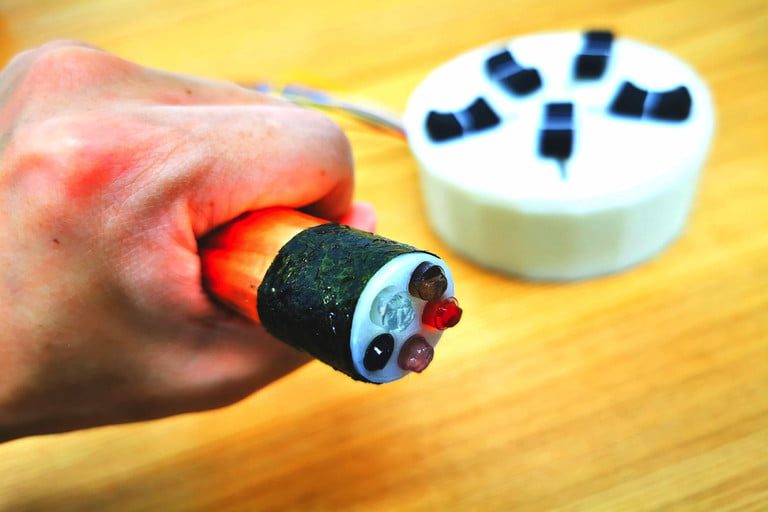In a world where technology continually surprises us, Homei Miyashita, a researcher at Japan’s Meiji University, has concocted something truly remarkable—the Norimaki Synthesizer. Imagine a handheld device that lets you taste food without actually eating it. Sounds like science fiction? Well, it’s real.

What is the Norimaki Synthesizer?
The Norimaki Synthesizer is akin to a handheld screen that you can taste. Named after ‘norimaki’, a type of sushi rolled in seaweed, this device allows users to experience the taste of foods like sushi without consuming any actual food. The name was inspired during one of its initial demos, where the device was wrapped in seaweed to enhance the illusion of eating sushi.

How Does It Work?
Imagine a colour display that mixes red, green, and blue to create various hues. The Norimaki Synthesizer does something similar but with flavours. It uses a combination of five gels corresponding to the five basic tastes our taste buds recognise: sweet, salty, acidic, sour, and umami.
Like an optical display that uses light of three basic colors to produce arbitrary colors, this display can synthesize and distribute arbitrary tastes together with the data acquired by taste sensors
Homei Miyashita, (2020). Norimaki Synthesizer: Taste Display Using Ion Electrophoresis in Five Gels
Through a process known as ion electrophoresis, an electric current is applied to these gels, causing them to interact directly with the user’s tongue. This interaction can be tuned to simulate different flavours. For those interested in the more technical aspects, Miyashita’s paper, Norimaki Synthesizer: Taste Display Using Ion Electrophoresis in Five Gels, explains this fascinating process.
Beyond Sushi: Future Applications
- Virtual Feasting:Imagine virtually savouring dishes you’ve never tried. Nutella for the nut-allergic? Check. Vegan chicken nuggets for the eco-conscious? Absolutely. The Norimaki Synthesizer could revolutionise how we experience food, making dietary restrictions a thing of the past.
- Education and Entertainment: Culinary schools could use it for flavor training. Foodies might attend virtual tasting events. And who wouldn’t want to “eat” their favourite movie’s iconic dish while watching it on screen?
- Health and Wellness: Managing diabetes or allergies? The Norimaki Synthesizer could be your ally. It’s like having a personal taste tester—minus the calories.
Potential Challenges and Limitations: The Bitter Aftertaste
As with any culinary adventure, there are caveats. Imagine accidentally tasting a spreadsheet or a cat meme—yikes! Plus, what if the gel mix-up leads to a flavour fiasco? And ethical questions arise: Is virtual gluttony a sin? We’ll chew on these dilemmas.
Despite its potential, the Norimaki Synthesizer faces significant challenges before it can be widely adopted. One of the primary hurdles is ensuring the safety and efficacy of the device for long-term use. There are concerns about the potential health implications of using electrophoresis to deliver tastes directly to the tongue. Furthermore, the device’s ability to accurately replicate complex flavours needs to be rigorously tested and validated.
Another challenge is the practicality of integrating this technology into everyday life. The device currently exists only as a prototype, and scaling it for mass production may present logistical and economic challenges. Additionally, user acceptance and adaptation to such a novel concept could be gradual, requiring extensive educational efforts to demonstrate its benefits and safety.
In conclusion, the Norimaki Synthesizer exemplifies modern technological advancements and offers exciting possibilities for the future. However, significant research, development, and validation are required before it can be made available for public use. As this technology evolves, it could revolutionise the way we experience food, providing safe and enjoyable alternatives for people with dietary restrictions or health conditions.
What do you think about the potential of tasting technology? Could it change the way we interact with food? Share your thoughts and join the conversation with MindBrews!
Glossary
Word: Umami
Sentence within the article: It uses a combination of five gels corresponding to the five basic tastes our taste buds recognise: sweet, salty, acidic, sour, and umami.
Meaning: Umami is one of the five basic tastes, alongside sweet, salty, sour, and bitter. It is a savory taste often associated with foods like meat, cheese, and tomatoes.
Ion Electrophoresis
Sentence within the article: Through a process known as ion electrophoresis, an electric current is applied to these gels, causing them to interact directly with the user’s tongue.
Meaning: Ion electrophoresis is a process where an electric current is used to move ions (charged particles) in a medium, in this case, the gels in the device. This interaction simulates different flavours on the user’s tongue.